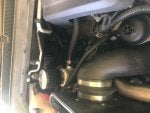I have a 2018 Colorado ZR2 extended cab Duramax. Lots of people have talked about rerouting the CCV to atmosphere but I couldn't find anyone who explained it in detail, or took pictures of doing it. So I hope this helps someone out. I originally ran a Provent 200 for less than 500 miles and it worked but if I would have done this first it would have saved me $135 on the Provent, and you don't have to buy the expensive filters for the unit this way either. So I have a lightly used Provent 200 for sale if anyone is interested.
In the pictures I have written how I did the reroute. If you have any questions let me know. It was extremely easy. Been running the truck for a couple hundred miles and no issues except I'm now longer coating my entire intake system with oil. I also never smell any fumes in the cab since it vents right in front of the rear bumper.
Yes I removed my engine cover and all the sound deadening crap because I like the diesel engine sound and it makes it easy to access the engine quickly, if anyone was curious.
In the pictures I have written how I did the reroute. If you have any questions let me know. It was extremely easy. Been running the truck for a couple hundred miles and no issues except I'm now longer coating my entire intake system with oil. I also never smell any fumes in the cab since it vents right in front of the rear bumper.
Yes I removed my engine cover and all the sound deadening crap because I like the diesel engine sound and it makes it easy to access the engine quickly, if anyone was curious.













